#rock swag tournament igneous rocks
Explore tagged Tumblr posts
Text
Rock Swag Tournament Round 1: Igneous Rocks Part 4
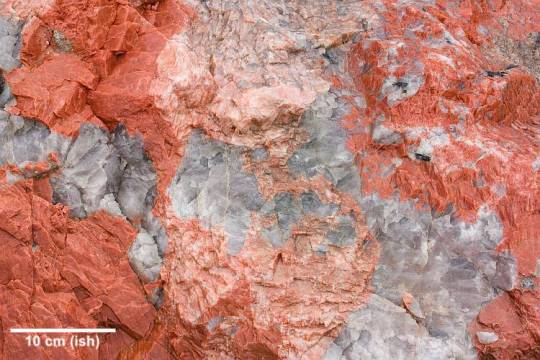

So these are two pretty fun igneous rocks, and the reason they're paired up is because neither of these two rocks has a defined composition. Granite is felsic, basalt is mafic, etc.
Now, many pegmatites are generally felsic, but it's not a requirement for pegmatites. Instead, what defines a pegmatite are the massive crystals it contains! I was taught, by a professor who does her research on pegmatites, that a good rule of thumb for when a rock is a pegmatite is when individual grains are bigger than a US quarter, but I've seen sources say grains have to be bigger than 1 cm. And, of course, in the sample shown above, those grains are more than 10 cm big.
All of that being said, one of the submitters to this competition ALSO has PhD research experience on pegmatites! I'll let them take it from here.
Pegmatites can have ENORMOUS crystals, rare minerals, and also gorgeous textures! Gemstone varieties of tourmaline, beryl, kunzite, etc. can come from pegmatites! My PhD research is on pegmatites XD
If this person would like to provide more information about pegmatites, I would be thrilled to hear it!
As for porphyry, while there is no compositional requirement, certain rocks like andesite and dacite are commonly porphyritic. One submitter actually sent in a specific type of porphyry called a rhomb porphyric (in English), named for its rhombic phenocrysts (the chocolate chips in the rock-cookie).

Here is what they have to say:
Found in Norway, east-Africa and Antartica. They look amazing! and can be found here in Denmark as a result of ancient glacier-movements - I am always super hyped to find one of these beauties. Plus the Danish name (rompeporfyr) sounds alot like rumpe-på-fyr meaning ass-on-guy (a more moderne translation might be Caked Up Dude) and I have been in love with that fact, and that stone, since I found out in grade 3.
Happy voting!
124 notes
·
View notes
Text
Rock Swag Tournament Round 1: Igneous Rocks Part 8
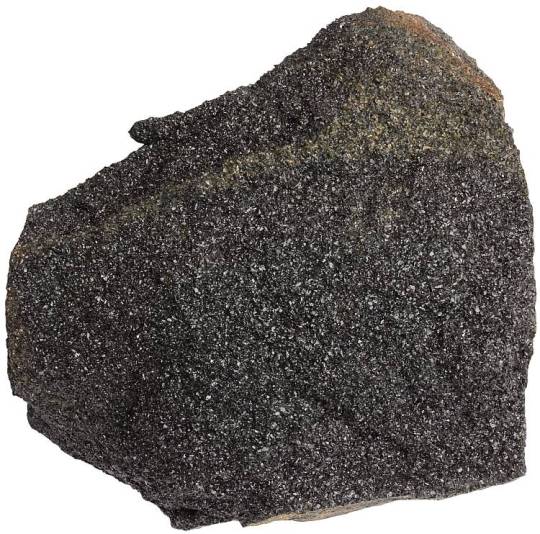

Once again we have some rocks named after minerals! This time, they're both ultramafic. Also this time, we also have a fun diagram to look at.

Ternary plots, very useful but sometimes difficult to plot on (at least for me. I always confuse myself, even now). But we're not plotting anything, we're just looking at trends!
If you look at the three corners of this triangle, you will see they are labelled Ol for olivine), Opx for orthopyroxene, and Cpx for clinopyroxene. These corners tell us what three things we are comparing the proportions of. In this case, we are comparing what percent of olivine, orthopyroxene, and clinopyroxene are in a rock (and what we call that rock based on the relative amounts of these minerals).
Ternary diagrams can have any three things in the corners, but you'll often see QFL (Quartz, Feldspar, Lithics) diagrams to classify sedimentary rocks, or sand-silt-clay diagrams for soil texture. You can also stick two triangles together to make a diamond for something like a QAPF diagram where the four points are quartz, alkali feldspar, plagioclase, and feldspathoids. QAPF diagrams are also used to classify igneous rocks (you can plot syenite and monzonite on them, as well as your granites).
The closer you get to the top corner of the triangle, the more olivine you have. The closer you get to the right corner of the triangle, the more clinopyroxene you have, and the closer you get to the left corner of the triangle, the more orthopyroxene you have.
If your rock sample plots in the top half (ish) of the triangle (at least 40% olivine), your rock is a peridotite. Now, depending on the relative amounts of pyroxene minerals, you may have different types of peridotite like lherzolite, wherlite, harzburgite, or dunite.
In the picture of peridotite above, the peridotite is actually the xenolith (the green rock embedded in the black rock) and it would be considered dunite because it is more than 90% olivine. The reason a rock full of olivine is called peridotite is because peridot is another name for olivine (specifically gemstone-quality olivine).
As for pyroxenites, if you have less than 40% olivine, the rock would be a pyroxenite. If it's almost all pyroxene (no more than ~5% olivine, at the bottom of the pyramid), it would be called websterite.
As for other facts about the rocks, both peridotite and pyroxenite are typically intrusive, phaneritic rocks derived from the mantle. Peridotite is going to be some shade of green because of the olivine, and pyroxenite is usually black or at least dark in color.
I'm also thinking of making an informational post about volcanoes, partial melting (and magma composition) and how these rocks/magmas get from the mantle to the surface, so look out for that at some point (I know myself better than to name a specific timeline).
124 notes
·
View notes
Text
Rock Swag Tournament Round 1: Igneous Rocks Part 3
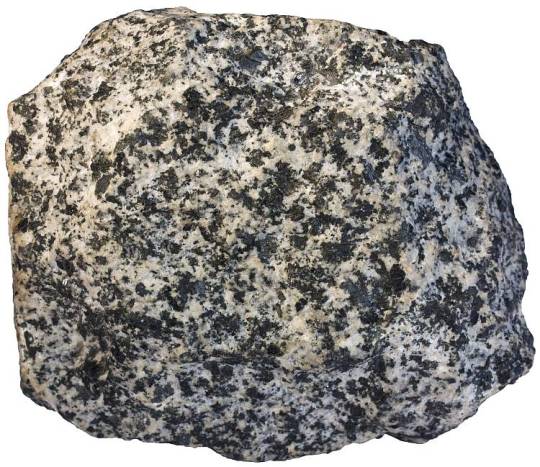
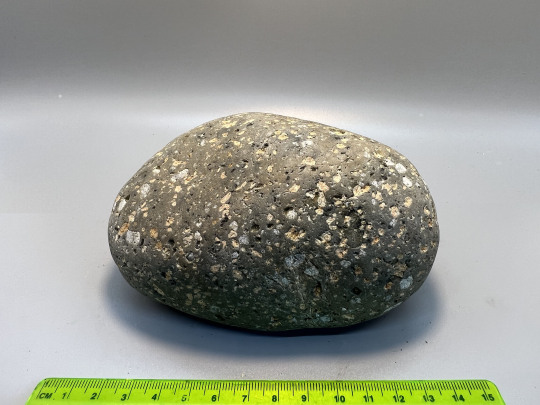
Diorite and andesite aren't the same rock, but they do have the same composition!
Both diorite and andesite are intermediate in composition, meaning they contain some mafic and some felsic minerals. In fact, diorite and andesite are considered, compositionally, the middle ground between felsic rocks like granite (phaneritic) & rhyolite (aphanitic) and gabbro (phaneritic) and basalt (aphanitic).
In diorite, the white minerals you see are mostly plagioclase (specifically sodium-rich feldspar). The black minerals are mostly biotite and amphibole, with maybe some pyroxene. While you can't see the individual mineral grains in andesite, the overall composition is just about the same as diorite.
And of course, that means if the difference is not composition, it is texture! Although it would probably be more correct of me to say that the difference is in where these rocks formed.
Diorite is an intrusive, phaneritic rock. It formed slowly so you can see the mineral grains that grew over a long period of time.
Andesite is an extrusive rock, which generally means it is aphanitic (fine-grained). However, this particular sample is porphyritic in texture! The white minerals in this sample were crystallized before the andesitic magma that made this rock was erupted. If you zoom in, you might be able to see that the andesite groundmass (the rock that these white minerals are embedded in) is aphanitic.
And, in cases like this, when andesite is porphyritic (which is pretty often), you will often hear it called an "andesite porphyry."
I would also be remiss not to mention that I have often heard these rocks referred to as various popular cookies! Diorite is of course an oreo (some may consider plagiogranite the oreo rock, but I give diorite this distinction) and andesite porphyry is a chocolate chip cookie.
123 notes
·
View notes
Text
Rock Swag Tournament Round 1: Igneous Rocks Part 2
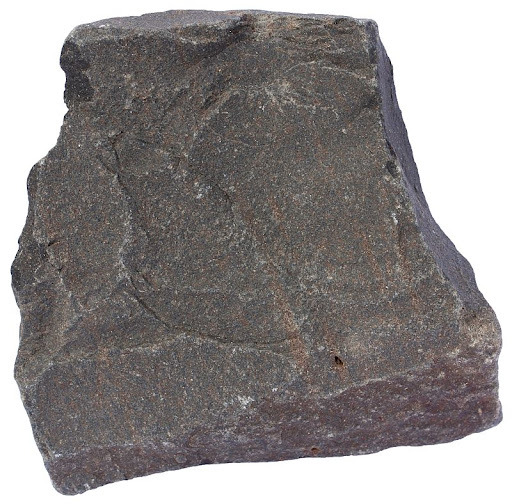
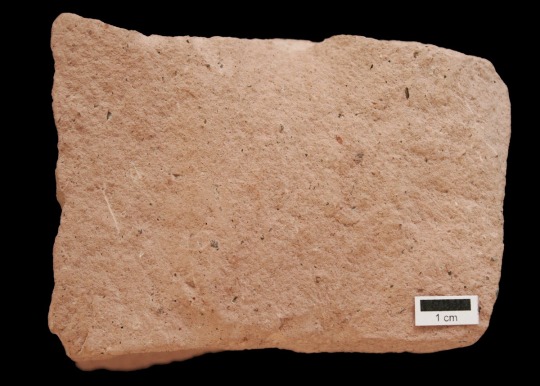
Well, these rocks certainly look like "just some rock" when you compare them to something like granite, but they still have a lot going on!
Both basalt and rhyolite are aphanitic and extrusive rocks, meaning they are fine-grained and formed at earth's surface. You cannot see the individual minerals that make up these rocks without a microscope!
The difference in these rocks is in their composition: basalt is a mafic rock (made of dark colored minerals), while rhyolite is a felsic rock (made of light colored minerals).
Confused about these words? Check out this primer on igneous rocks! I made it myself.
Basalt is the rock that makes up much of the island of Hawai'i. Basalt also forms in places like the Mid-Atlantic Ridge where the North American tectonic plate is moving away from the Eurasian and African plates. Basaltic lava is relatively viscous (it flows quickly) but you could still very easily outrun (or even outwalk) it!
Rhyolite is more commonly found on continents and is associated with much more explosive volcanic eruptions than basalt. Felsic magmas are much more viscous (i.e. thick) and they usually have more volatiles (water, gasses, etc), so they will build up pressure before explosively erupting. These eruptions are, of course, accompanied by a variety of other rocks which will fight to the death in this tournament.
119 notes
·
View notes
Text
Rock Swag Tournament Round 1: Igneous Rocks Part 1

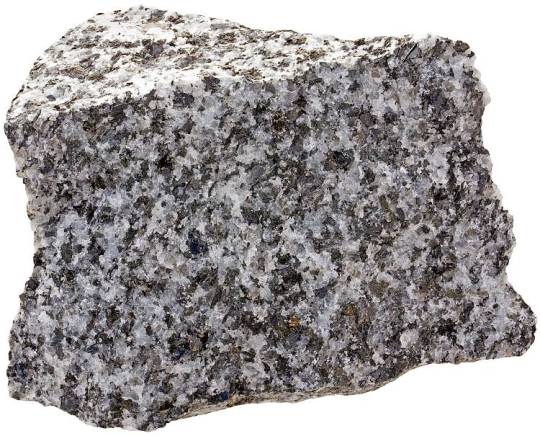
Pink or White?
Both of these rocks are GRANITE which means they are coarse-grained (phaneritic) rocks that contain at least 20% quartz and no more than 10% mafic minerals. The rest is some kind of feldspar. Mafic minerals are the black grains you see in the samples above and are most likely the minerals pyroxene, amphibole, or biotite.
(Want to learn more about igneous rocks and how we classify them? Click here for an igneous rocks introduction)
The distinction between these two granites comes with the type of feldspar contained in the rock.
The feldspar content in alkali granite is almost entirely orthoclase (aka k-spar or potassium feldspar). The pink grains in this rock are orthoclase crystals. Fun fact, my dad's headstone is an alkali granite and the specific variety used is called "North American Pink."

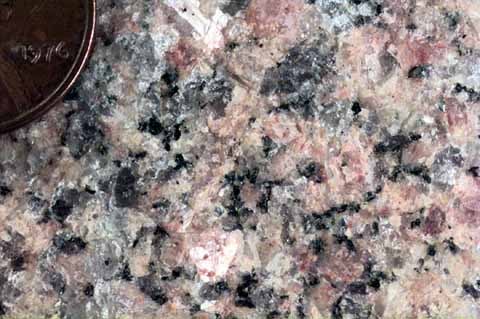
Other alkali granite samples.
The feldspars that make up plagiogranite (also known as tonalite) are almost entirely plagioclase feldspar, which contain calcium or sodium instead of potassium. These are typically dark grey to white in color. In this particular sample, the white grains are sodium feldspar (aka albite).
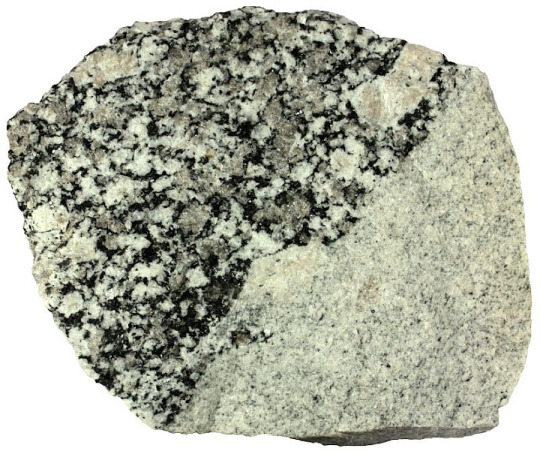

More tonalite/plagiogranite samples.
#i had to mention my dead dad because i love him so much it was not intended to sway anyone's vote#there are other headstone colors out there and many are tonalite or maybe even diorite#my family owns a headstone company but the companies don't usually say what minerals are in the rocks they use#they just have fun names. and also some of the granites used in things like headstones and countertops aren't technically granite#rock swag tournament round 1#rock swag tournament igneous rocks#geology#igneous rocks
103 notes
·
View notes
Text
An Igneous Rocks Primer, for Interested Parties
First off, what even is an igneous rock?
Put simply, igneous rocks are rocks made from molten material. We call the molten material lava when it is on the earth’s surface and magma when it is below the earth’s surface. When it has cooled and hardened, we call it an igneous rock!
There are 24 different types of igneous rocks in the tournament (and many more not in the tournament!). How do you tell them all apart?
I’m so glad you asked. We generally classify igneous rocks using two criteria: texture and composition.
More below the cut!
Texture, what does that mean?
There are a few forms that igneous rocks typically come in, and they have to do with how the magma or lava cooled and hardened.
Aphanitic (fine-grained) rocks are igneous rocks where you cannot see individual mineral grains with the naked eye. You would need a microscope to see the individual crystals. Aphanitic rocks form when a lava cools above the earth’s surface. For example, the lava that erupts from Mauna Loa and makes up the island of Hawai’i cools relatively quickly, and minerals do not have time to form large grains.

They cool quickly relative to what? Relative to phaneritic (coarse-grained) igneous rocks!
With phaneritic rocks, you CAN see the individual crystals making up the rock—like granite. Phaneritic rocks cool deep in the earth’s crust, rather than on the surface from a volcanic eruption. Magma chambers within the crust are insulated and therefore cool much slower than lava exposed to air or water at the earth’s surface. This slow cooling gives the minerals the time they need to crystallize and form grains big enough for us to see.
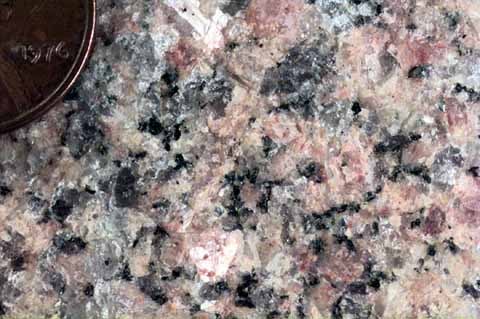
While aphanitic and phaneritic refer to the texture of the rock (fine-grained and coarse-grained), you will often hear rocks with an aphanitic texture being called “extrusive” rocks and rocks with a phaneritic texture being called “intrusive” rocks.
This is because the texture and size of mineral crystals directly correlates with how quickly the melt cooled, which correlates with where the rock originated. Extrusive rocks form quickly on the earth’s surface (externally) during events like volcanic eruptions. Intrusive rocks form slowly beneath the earths surface (in the crust) from bodies of magma (plutons) in the crust.
Some other igneous textures are:
Glassy (like obsidian) which happens when a lava cools extremely quickly even compared to aphanitic rocks.
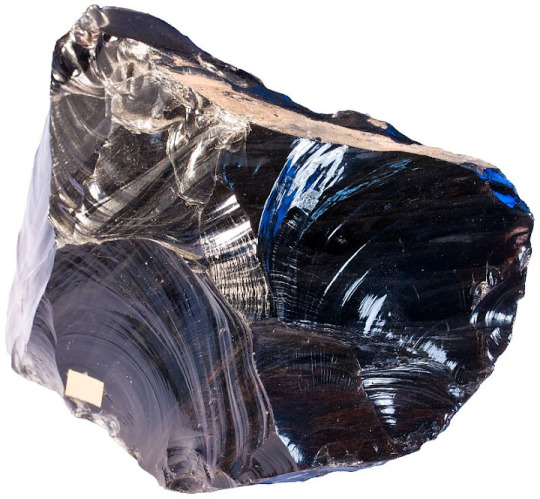
Vesicular (like pumice) which happens when a lava cools very quickly, while gasses are creating bubbles in the lava, so the rock forms with holes (called vesicles).
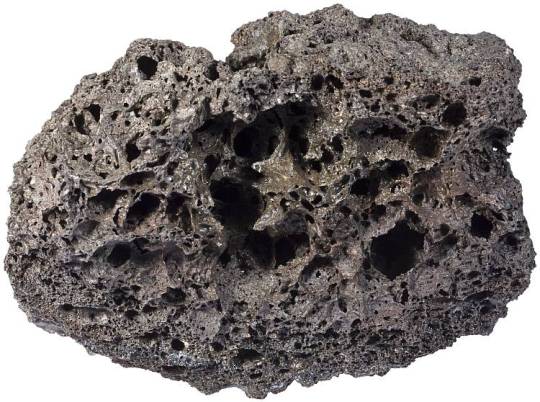
Porphyritic (there isn’t really a universally known example, except for maybe the rhomb porphyry) which happens when a magma cools in two stages. Different minerals crystalize at different temperatures (more on that later), so this rock looks like an aphanitic rock with isolated crystals (called phenocrysts). The most effective way I have ever heard this described is as a “chocolate chip cookie rock” because the phenocrysts look like the chocolate chips in the aphanitic cookie.
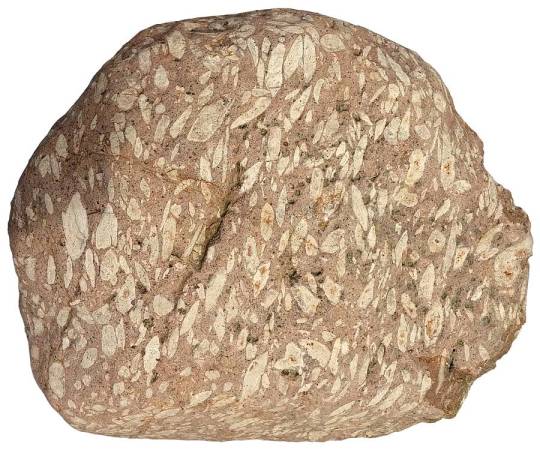
Okay, that was a lot, what about composition?
There are different minerals that make up the different types of rocks. There are about eight minerals that commonly make up igneous rocks and we use their relative abundances to define igneous rock compositions!
We describe igneous rock composition using a few words: ultramafic, mafic, intermediate, and felsic.
To understand what these words mean, I would like to introduce Bowen’s Reaction Series!
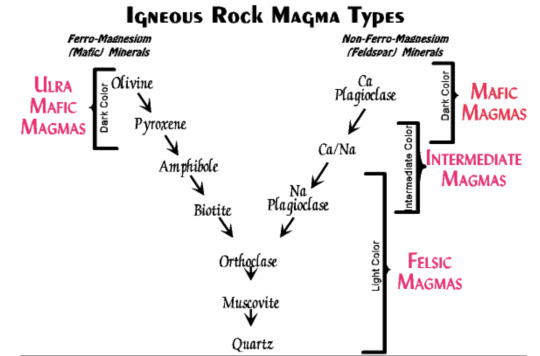
This image (and the image of granite shown above) are from this site which is an absolutely INCREDIBLE source for all kinds of geology information.
This diagram is organized based on the relative crystallizations temperatures of these minerals.
So, looking at Bowen’s Reaction Series (thanks, Norman Bowen!) minerals at the top (olivine and calcium (Ca) plagioclase) crystallize at higher temperatures than minerals at the bottom (quartz). Olivine crystallizes at a higher temperature than pyroxene, which crystallizes at a higher temperature than amphibole, and so on. Compare this to iron and water. Iron requires a lot more heat to become a liquid than water does. Similarly, olivine requires more heat to become molten than quartz does.
So, what does this have to do with ultramafic, mafic, intermediate, and felsic rocks?
Ultramafic rocks (like peridotite) contain almost entirely the minerals on the top left: olivine and pyroxene. These minerals contain a lot of iron and magnesium. Ultramafic magmas originate from the mantle.
Mafic rocks (like basalt) contain mostly minerals towards the top of Bowen’s Reaction Series: calcium (Ca) plagioclase, olivine, pyroxene, amphibole, and biotite. The minerals on the left branch contain magnesium and iron, while the minerals on the right branch do not. The parts of earth’s crust that make up the ocean floor (the oceanic crust) are mafic.
Another convenient pattern: all the minerals at the top of the reaction series (the mafic and ultramafic minerals) are dark in color.
Felsic rocks (like granite) contain mostly minerals on the bottom of the reaction series: quartz, muscovite, orthoclase, and sodium (Na) plagioclase. These minerals are, conveniently, light in color and lack iron and magnesium. The parts of earth’s crust that make up the continents (the continental crust) are felsic.
Intermediate rocks (like diorite) contain some dark/mafic minerals and some lighter/felsic minerals and therefore have a color somewhere in the middle. These rocks typically form above subduction zones, where the oceanic crust gets pushed under the continental crust (for example, on the west coast of the United States).
Wow. I knew you were long winded, but that was intense.
Yeah, thanks for sticking with me. It’s a lot of background to get to the point which is: we use two criteria to classify rocks.
Granite is a phaneritic (coarse-grained) felsic (light colored) rock.
Basalt is an aphanitic (fine-grained) mafic (dark colored) rock.
Diorite is a phaneritic intermediate rock.
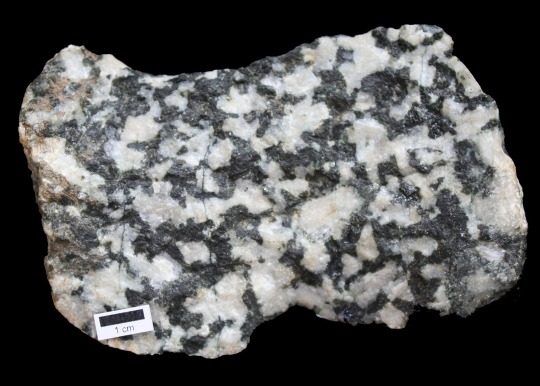
Here's diorite, by the way. See how it's half dark rocks and half light rocks?
Oh and one last thing, porphyritic rocks?
Right, now that you know about Bowen’s Reaction Series, it might make more sense to you that you could have pyroxene crystals (that crystalized over a long period of time) floating in a more felsic magma, which has not yet cooled because the temperature may be low enough for pyroxene to crystallize, but not for the minerals lower on Bowen’s Reaction Series to crystallize. If this magma were then to erupt, the magma would cool fairly quickly and form an aphanitic rock, but it would still have these pre-crystallized pyroxenes visible.
—————
Anyway, I wanted to throw this together so you all can at least have a reference (if you want it. If you want to vote based on rock pretty, I would be foolish to stop you) when I say things like “granite is a phaneritic felsic rock.”
If you want even more information about different volcano and eruption types and the rocks they produce, there will be a link to click here coming soon (don't ask me how soon, but feel free to send questions in the meantime!)
65 notes
·
View notes
Text
Rock Swag Tournament Round 1: Igneous Rocks Part 12

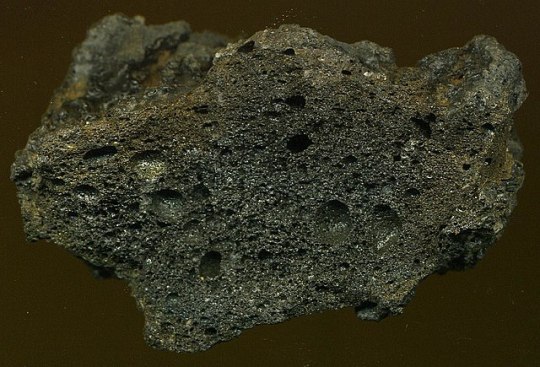
So many of your here may know of obsidian. I haven't a clue why.
For those of you unfamiliar, obsidian is a form of volcanic glass, but it is not the only one! Tachylite is obsidian's much less well-known sibling.
Now, I'm going to go against everything I talked about in earlier posts, because while obsidian is black (or sometimes a reddish-brown) it is FELSIC! That babey has very few of those dark mafic minerals, but the little bit of iron and magnesium combined with the quick cooling (and therefore lack of individual crystals) gives obsidian this dark color.
Tachylite on the other hand is mafic! It, like obsidian is a volcanic glass that cools very quickly and lacks mineral grains, but it does contain all those dark mafic minerals at the top of Bowen's Reaction Series.
Also, I wanted to take the time to correct a small misconception in that post about obsidian weaponry. And I'm not here to spoil the fun, don't worry. I do adore that post and it makes me laugh whenever I see it. This is instead, a bit of an archaeology lesson. More under the cut.
While the geologist in question argues that an obsidian knife would make a poor weapon because it volcanic glass, I am here to say that obsidian was actually frequently used for weaponry and tools (and that ended up being a very good thing for archaeologists)!
Now, I will admit that these obsidian artifacts are often on a smaller scale: things like arrowheads and small blades and not long knives. One form of weaponry, the macuahuitl, was made by embedding small obsidian blades into a club!
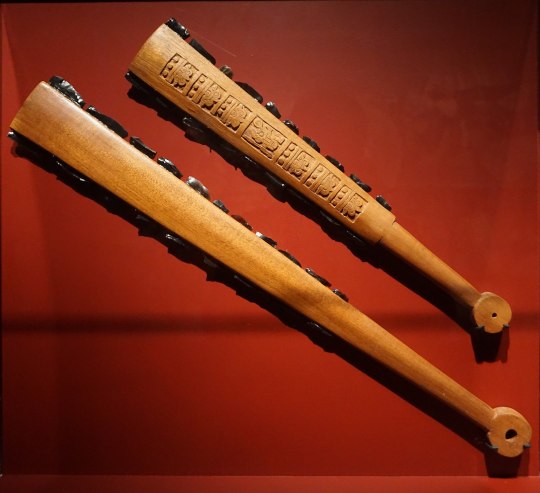
The reason obsidian is actually an effective weapon is because it is easy to work with and very sharp. While it is certainly more prone to breakage than metal when banged against hard objects, it makes for an extremely sharp and effective blade when used for slicing, rather than to cause blunt force trauma. In fact, a freshly broken piece of obsidian can be sharper than a steel blade. So it certainly isn't out of the question to make an use an obsidian knife. You just might have to be a bit more careful when swinging it around near hard surfaces.
I should also note that these artifacts were made through a process called knapping, wherein someone strategically chips away at a piece of material (often flint, obsidian, or some other material that has conchoidal fracture, or fractures in a way that shows concentric lines similar to growth lines on a shell) to form a shaped tool, weapon, blade, etc.

Here's an obsidian arrowhead. It has been shaped to have notches where it could be affixed to the shaft of an arrow, a pointed tip, and sharp, thin edges that would cut through the hide of the creature being hunted.
So, obsidian was used for tools and weapons that necessitated slicing more than banging. And an obsidian sword probably wouldn't be very effective. If you bang it against the stone battlement by accident, it'll break. And I could believe that the force needed to stab someone clean through with a sword would cause an obsidian blade to break. I haven't tested this theory. But when used as a small cutting blade affixed to something like a club or an arrow, its pretty effective! If they weren't effective, people wouldn't have used them so much throughout history.
And that brings me to why obsidian artifacts are so important for archaeology! Volcanoes have their own unique geochemical signatures, which means we can trace pieces of obsidian back to the volcano from which it erupted.
This is incredibly helpful for archaeologists who want to learn about things like trade and travel between ancient peoples. If you find an obsidian arrowhead a thousand miles from the volcano from which that obsidian came, you know that a person had to travel a thousand miles to move that piece of obsidian. Volcanic rocks don't really move a thousand miles from their source without a little human intervention. A real person at some point in time had to help that rock out! It's endlessly fascinating, that least to me.
Anyway, if this rant proves anything, it is that I, too, would be prone to getting hit by a baseball bat while I rant about obsidian blades in a somewhat more archaeologically-informed way!
82 notes
·
View notes
Text
Rock Swag Tournament Round 1: Igneous Rocks Part 10


Two vesicular beauties!
Vesicular rocks like these form when a magma contains many volatiles--things like gasses or water--that expand and bubble during an eruption, often of the explosive variety.
Pumice is notable for its low density (due to the holes and pockets) that allows it to float in water! Also notable is the fact that Pompeii is buried by ash and pumice stones.
Scoria is more dense than pumice, so it does not float, but it is often red in color! Scoria forms from less volatile-rich magmas as it is generally more mafic than pumice.
61 notes
·
View notes
Text
Rock Swag Tournament Round 1: Igneous Rocks Part 11
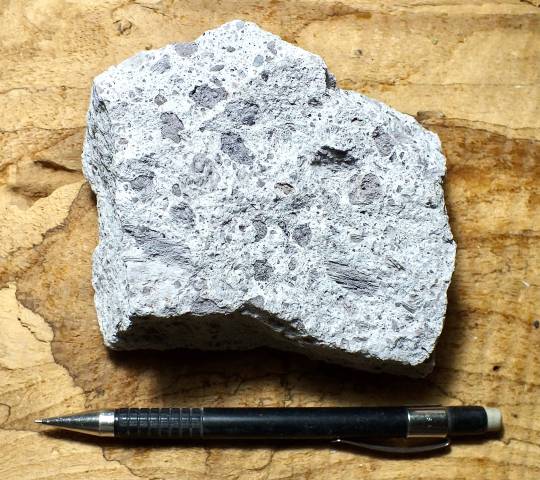

Tuff is an igneous rock...or maybe a sedimentary rock based on who you ask! It is made of lithified volcanic ash (lithification is the process by which particles of stuff become rock, and volcanic ash is sand grain-sized pieces of ejected volcanic matter).

Tuff generally also has pieces of all kinds of other stuff, as well. As long as stuff that is 2 mm or smaller makes up 75% of the rock, it will be considered tuff. Anything less than 75% volcanic ash, and the rock is described as "tuffaceous."
Fun fact: the Moai on Rapa Nui (Easter Island) are made of tuff! Also, according to one submitter, "this is one of the few volcanic rocks that can be made into a really lovely paint. Specifically a vaguely purplish gray" COOL!
Ignimbrite could be considered a type of tuff, but it is more specifically a rock formed from a pyroclastic flow deposit. Pyroclastic flows are one of the deadliest geological phenomena as they are burning hot clouds of gas and debris that race down the sides of volcanoes during some eruptions!
Ignimbrites can have more and larger pieces of volcanic debris, but they could also simply be tuffs that have welded due to the high heat from an eruption. Ignimbrites also may contain fiamme, which are "flame-shaped" lapilli (volcanic tephra or debris between 2 and 64 mm big) that have been flattened or sheared during deposition.

More on pyroclastic flows under the cut, because they are fascinating in that they are dangerous and I must talk about them.
Pyroclastic flows are blisteringly hot and terrifyingly fast clouds of volcanic gas and assorted tephra: volcanic material that can include ash (particles less than 2 mm), lapilli (between 2 and 64 mm), and blocks and bombs (greater than 64 mm).
They flow (violently rocket) down the side of volcanoes after explosive eruptions. You generally don't have to worry about pyroclastic flows on Kīlauea any time soon because those eruptions are mostly lava flows (which you can usually outrun). However, some of the most famous volcanic eruptions from recorded human history--Mount St. Helens in 1980, Krakatoa in 1883, and Vesuvius in 79 CE--were accompanied by pyroclastic flows.
Pyroclastic flows can be triggered a number of ways. Some examples are lava domes collapsing and causing an avalanche of sorts, part of the volcano exploding or collapsing in one direction (like Mount St. Helens), or the plume of debris and gas that is shot vertically into the air during an eruption collapsing back down to the surface (like Mount Vesuvius).
There is no outrunning a pyroclastic flow. They flow down the side of volcanoes and across the surrounding landscape at typical speeds upwards of 80 km/h (50 mph), but they can reach speeds of several hundred km/h. These clouds of debris are also several hundred degrees Celsius. You do not survive a pyroclastic flow!
If you would like to see what one of these looks like, I have two videos. Please be warned that because pyroclastic flows are so deadly, one of these two videos discusses deaths related to a specific eruption.
This video is from a documentary (I do not know the name of the film) and the beginning shows the genesis of the pyroclastic flow: the lava dome collapses and causes an avalanche. The pyroclastic flow then moves along a stream valley and close to a nearby town. CW: This video mentions the number of deaths directly related to this eruption and pyroclastic flow. There is footage of a vehicle and a person fleeing the pyroclastic flow, but the town they are in is are far enough away that the pyroclastic flow does not reach their location, and they survive. The potentially triggering part of the video begins at 0:24.
This video shows a pyroclastic flow going into the ocean. CW: As far as I can see, there are no people or animals in the path of the pyroclastic flow in this video and so there are presumably no deaths associated with this eruption.
75 notes
·
View notes
Text
Rock Swag Tournament Round 1: Igneous Rocks Part 9


This is a matchup I've been looking forward to because both of these rocks do not currently form on earth, which is so cool.
Remember Bowen's Reaction Series? (Find it here, along with other igneous rock information). It tells us that certain minerals (particularly those with a lot of silica) require less heat to become molten. Meanwhile, our ultramafic minerals take a lot of heat to do the same.
Well, right now, the earth is plenty hot enough to melt mafic and felsic magmas. However, the earth has been cooling down over its 4.5 billion years of being a planet. Of course, the atmosphere is undoubtedly heating up due to human activity as we sit here and read this, but both the atmosphere AND the inside of the earth used to be much hotter. And it's a good thing, because if earth didn't cool off, we would all be super dead.
And so, a consequence of the earth cooling down is that ultramafic magmas really don't erupt anymore, which means ultramafic igneous rocks don't form anymore!
Komatiite specifically contains a lot of mangesium, and often shows spinifex texture, which is when olivine forms needle-like (acicular) grains.

And here's a word on kimberlite from out submitter (who also provided the picture at the top of the poll):
Type of peridotite that erupts from deep mantle sources in the form of diatremes (basically inverted volcano cones that are holes in the ground, sometimes called pipes). Commonly hosts diamonds bc it hits the diamond stability zone inside the mantle on the way up, but also brings up other xenoliths. Composition is mainly forsterite olivine [magnesium-rich olivine] and carbonates. When kimberlite magmas erupt they are extremely explosive due to the insane amounts of volatiles in it (one research calculated an ascent rate of 30 m/sec in comparison to Hawaiian type volcanoes having an ascent rate of 1.7 m/sec as its fastest...so that is CRAZY FAST). It's named after the Kimberly mines where it was first discovered BTW

And here's a kimberlite with a big ol' diamond.
And that's all from me unless anyone has questions :)
60 notes
·
View notes
Text
Rock Swag Tournament Round 1: Igneous Rocks Part 7


These rocks are both named for the minerals they contain.
Anorthosite is almost entirely made up of the mineral anorthite (like, at least 90% of the rock has to be made of it), which is our calcium-rich plagioclase feldspar. Anorthosite is not very common on earth, but it is very common on the moon! The prevailing theory is that anorthosite was much more common in the early days of earth, although no one really knows how it forms.
Nephelinite mostly nepheline, which is a feldspathoid (not quite a feldspar), and some pyroxene. While it looks similar to basalt and has a sort of similar composition, basalt has more silica because feldspathoids contain little silica. In the image above, the yellow xenolith is peridotite.
52 notes
·
View notes
Text
Rock Swag Tournament Round 1: Igneous Rocks Part 5


Dacite and gabbro have nothing in common aside from the fact that they are both igneous rocks!
Dacite is an aphanitic (though often porphyritic) felsic to intermediate rock. As far as composition goes, it is somewhere between rhyolite and andesite (so more on the felsic side of intermediate).
Gabbro is a phaneritic mafic rock. It contains mostly calcium plagioclase and pyroxene. Gabbro sometimes looks a bit greenish and this can be from the pyroxene or very small amounts of olivine. That being said, all of the gabbro samples I've ever seen in my labs have been pretty much solely black, so while it is phaneritic, it can sometimes be difficult to tell the grains apart in a hand sample.
Maybe it was just my school but gabbro was the bane of people's existence (especially intro geology students) because our samples had almost no discernible features other than being lumpy black rocks. There was also a fellow geology major of mine who HATED gabbro for reasons I was never able to figure out. I personally think it's a neat rock.
39 notes
·
View notes
Text
Rock Swag Tournament Round 1: Igneous Rocks Part 6


Now you might be asking yourself, "are these rocks not plagiogranite and alkali granite?"
No, they are not. The difference? QUARTZ! Both of these rocks have very little quartz! In fact, they are made up of less than 5% quartz. Any more than that (up to 20%), they'd be called a "quartz monzonite" or a "quartz syenite." More than 20% quartz means you're finally in granite territory.
Otherwise, these are both phaneritic felsic rocks. Monzonite has more plagioclase than orthoclase, and syenite has more orthoclase than plagioclase. There are specific percents, but that's the gist!
32 notes
·
View notes
Text
A New Place for Important Posts
ROCKS:
Rock Swag Tournament Igneous Bracket (coming soon)
Igneous Rocks Primer
MINERALS:
Mineral Swag Tournament Original Bracket with Links
Mineral Swag Tournament Winner
MISC:
Original Fun/Fictional Tournament Bracket
Original Fun/Fictional Tournament Final
SUBMIT Fun/Fictional Rocks for the NEW tournament Here!
If you'd like anything else pinned, please let me know!!
19 notes
·
View notes